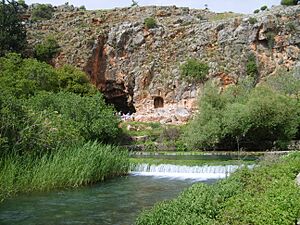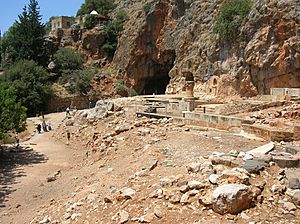Battle of Panium facts for kids
Quick facts for kids Battle of Panium |
|||||||||
|---|---|---|---|---|---|---|---|---|---|
| Part of the Fifth Syrian War | |||||||||
 The spring of Banias with the Cave of Pan in background |
|||||||||
|
|||||||||
| Belligerents | |||||||||
| Seleucid Empire | Ptolemaic Egypt | ||||||||
| Commanders and leaders | |||||||||
| Antiochus III the Great Antiochus the Younger |
Scopas of Aetolia | ||||||||
| Strength | |||||||||
| 70,000 men Unknown war elephants |
46,500–53,000 men 25,000–32,000 phalangites 6,000 Aetolian infantry 500 Aetolian cavalry 14,500–15,000 other troops |
||||||||
| Casualties and losses | |||||||||
| Unknown | 17,500–20,825 phalangites killed or captured | ||||||||
The Battle of Panium was a major fight that happened in 200 BC. It took place near a place called Banias in the Middle East. This battle was part of the Syrian Wars, a series of conflicts between two powerful ancient empires.
On one side was the Seleucid Empire, led by their king, Antiochus III the Great. On the other side was the Ptolemaic Kingdom (also known as Ptolemaic Egypt), whose army was commanded by a general named Scopas of Aetolia. The Seleucids won a huge victory, almost completely destroying the Ptolemaic army. They took control of a region called Coele-Syria. After this defeat, the Ptolemaic Kingdom lost much of its power.
Contents
Why the Battle Happened
In 202 BC, a governor named Ptolemy, who worked for the Ptolemaic Kingdom, switched sides. He joined Antiochus III the Great of the Seleucid Empire. Antiochus then invaded and took over most of the Coele-Syria region. This included the important city of Gaza.
By late 201 BC, Antiochus went back to Syria for the winter. But the Ptolemaic general Scopas of Aetolia used this chance. He fought back and won some parts of the region again. So, Antiochus gathered his army in Damascus. In the summer of 200 BC, he marched to face the Ptolemaic army. They met near a stream at Panium, close to Mount Hermon.
Armies Ready for Battle
Ptolemaic Army's Plan
The Ptolemaic army spread out over four kilometers. Their left side was on a flat area below the Panium plateau. This part had their best soldiers, about 25,000 to 32,000 Macedonian phalanx fighters. These were strong, well-trained troops.
The main commander for the Ptolemies was Scopas of Aetolia. He was a mercenary general from Aetolia. Scopas brought about 6,500 of his own soldiers. This included 6,000 infantry (foot soldiers) and 500 cavalry (soldiers on horseback).
Seleucid Army's Plan
King Antiochus III probably had around 70,000 soldiers. This was more than he had in an earlier battle in 217 BC. He had gained more land and resources, so he could gather a bigger army.
Historians mention that the Seleucid army had different types of fighters. They had elite cavalry called cataphracts. These were heavily armored horsemen. They also had other cavalry, phalangites (soldiers in a phalanx formation), and special guards called hypaspists. A very important part of their army was their war elephants. They also had other foot soldiers and light skirmishers (soldiers who fought in small, quick attacks).
The Battle Unfolds
The battle began in the night. Antiochus the Younger, who was King Antiochus III's oldest son, led the best Seleucid cavalry. They quickly took control of Tel Hamra, a small hill near Mount Hermon. These powerful horsemen then attacked the Ptolemaic cavalry. The Ptolemaic horsemen were caught off guard and quickly ran away.
In the middle of the battlefield, the Ptolemaic phalanx was pushing back the Seleucid phalanx. But then, the Seleucid war elephants charged. They moved through gaps in their own lines and stopped the Ptolemaic advance.
At the same time, Antiochus the Younger's cavalry finished chasing the Ptolemaic horsemen. They then turned and charged the back of the Ptolemaic phalanx. The Ptolemaic phalanx was now stuck. They were being attacked from two sides by war elephants, phalangites, and heavy cavalry. They couldn't move much and were almost completely wiped out right where they stood. General Scopas, who was on the right side of the Ptolemaic army, saw what was happening. He quickly fled the battle, taking about 10,000 soldiers with him.
What Happened Next
After the battle, Scopas and his 10,000 men tried to find safety in a city called Sidon. Other Ptolemaic soldiers fled to places like Jerusalem, Phoenicia, Samaria, and Decapolis. But by the end of 198 BC, all of them were forced to surrender to the Seleucids.
As a result, the entire region of Coele-Syria came under the control of the Seleucid Empire. The Ptolemies had to sign a peace treaty with Antiochus in 195 BC. This defeat was a huge blow to the Ptolemaic Kingdom. They had to reduce the role of their Macedonian phalanx soldiers in the years that followed. The Battle of Panium showed that the Seleucid Empire was a very strong power in the ancient world.
Images for kids




